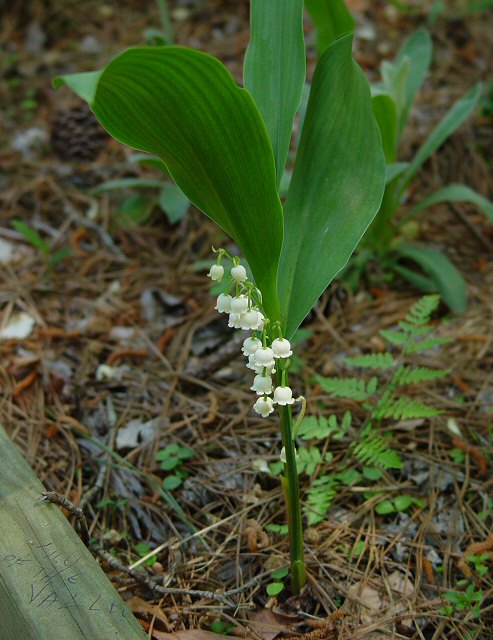Convallaria majalis L.
Lily Of The Valley

Introduced
CC = *
CW = 5
MOC = 10
© DETenaglia
Convallaria majalis L.Lily Of The Valley | |
 |
Introduced CC = * CW = 5 MOC = 10 |
© DETenaglia |
|
Family - Liliaceae Habit - Rhizomatous perennial forb, lacking odor of onion or garlic. Stems - Aerial stems 10-20 cm long, unbranched, arched, with 2-3 bladeless sheaths below the foliage leaves, glabrous. Leaves - 2-3 per node, oblong to elliptic, entire, 10-20 cm long, 4 cm broad, glabrous.
Inflorescence - Terminal raceme to 7cm long, with 4-16 flowers. Pedicels to 1 cm long, glabrous, with scarious bracts at base, these up to 8 mm long.
Flowers - Pendent, with stalks 10-18 mm long, none replaced by bulblets. Perianth 6-9 mm long, bell-shaped, white, glabrous, the sepals and petals fused into a tube nearly to the tips, the 6 short lobes spreading to recurved. Stamens 6, fused to the base of the perianth tube. Anthers pale yellow, to 2 mm long, tapering to point at apex. Filaments short, 1.5 mm long, pinkish-purple at base. Ovary glabrous, superior, 3-locular, each with 1-3 ovules. Style 1, 2.2 mm long, the stigma shallowly 3-lobed.
Fruit - Globose, red, fleshy, 8-10 mm in diameter. Flowering - April - May. Habitat - Old homesteads and cemeteries; cultivated and rarely escaping. Origin - Native to Europe and possibly the Appalachians. Lookalikes - None. Other info. - This species has been found in a few scattered counties in Missouri, usually persisting from prior cultivation. It can form large colonies under favorable conditions but is generally not considered a problem species in our area. It is somewhat more common in states to our north and east. The plant is easily recognized by its inflorescences of small white bells, which are sweetly fragrant. Photographs taken in Lochapoka, AL., 4-16-05 (DETenaglia); also in Fremont, Newaygo County, MI, 5-21-2013 (SRTurner). |